Preparation of 2D/2D CoAl-LDH/BiO(OH)XI1−X Heterojunction Catalyst with Enhanced Visible–Light Photocatalytic Activity for Organic Pollutants Degradation in Water
Abstract
:1. Introduction
2. Materials and Methods
2.1. Materials
2.2. Characterization
2.3. Catalyst Preparation
2.4. Photocatalytic Degradation Experiment
2.5. Optical Performance Testing
3. Results and Discussion
3.1. Structure, Morphology, and Surface Properties
3.2. Photocatalytic Degradation Activity
3.3. Effect of Different Reaction Conditions on Photocatalytic Degradation Activity
3.4. Stability of CoAl-LDH/BiSS
3.5. Mechanism of Photocatalytic Degradation
3.5.1. Photoelectric Response and Charge Separation Efficiency
3.5.2. Free Radical Capture Experiment
3.5.3. Band Structure Calculation
3.5.4. Possible Degradation Pathways of TC
4. Conclusions
Supplementary Materials
Author Contributions
Funding
Institutional Review Board Statement
Informed Consent Statement
Data Availability Statement
Conflicts of Interest
References
- Tao, Y.K.; Zhang, M.Z.; Huang, D.; Wang, M.Z.; Zhou, Z.R. Photocatalytic degradation and mechanism of tetracycline by metal doped WO3. Acta Sci. Circumstantiae 2023, 43, 62–75. [Google Scholar] [CrossRef]
- Kong, C.C.; Liu, Y.N.; Zeng, H.; Zhang, L.F.; Wang, W.; Li, J.D.; Wu, H.D.; Wu, K.; Guo, J. Facile synthesis of NiFe-CO32−-LDH/Sn4+-β-Bi2O3 microsphere S-Scheme heterojunction for efficient tetracycline photodegradation and hydrogen production. J. Environ. Chem. Eng. 2023, 11, 111551. [Google Scholar] [CrossRef]
- Zhang, K.J.; Meng, W.; Wang, S.Y.; Mi, H.; Sun, L.; Tao, K.N. One-step synthesis of ZnS@MoS2 core–shell nanostructure for high efficiency photocatalytic degradation of tetracycline. New J. Chem. 2020, 44, 472–477. [Google Scholar] [CrossRef]
- Liu, H.J.; Hou, M.C.; Fu, H.; Hu, A.J.; Zhai, Y.L.; Wang, L.W.; Zhai, D.; Zhang, S.L.; Wang, S.P. 2D/1D BiOBr/TiO2 flexible nanofibrous film heterojunction photocatalyst for tetracycline degradation. Surf. Interfaces 2024, 44, 103795. [Google Scholar] [CrossRef]
- Jo, W.-K.; Tonda, S. Novel CoAl-LDH/g-C3N4/RGO ternary heterojunction with notable 2D/2D/2D configuration for highly efficient visible-light-induced photocatalytic elimination of dye and antibiotic pollutants. J. Hazard. Mater. 2019, 368, 778–787. [Google Scholar] [CrossRef] [PubMed]
- Xie, Y.W.; Zhang, H.T.; Lv, J.; Zhao, J.Q.; Jiang, D.M.; Zhan, Q.F. Synthesis and characterization of Bi2SiO5–coated Ag/AgBr photocatalyst with highly efficient decontamination of organic pollutants. Appl. Surf. Sci. 2022, 578, 152074. [Google Scholar] [CrossRef]
- Fahimeh, B.; Reza, M.A.; Cheshme, K.A.H. Design and synthesis of Bi-doped NiAl-LDH/g-C3N4 heterostructure; a novel 2D/2D system for simultaneous enhanced photocatalytic degradation and fluorescence sensing of ciprofloxacin. Appl. Surf. Sci. 2023, 637, 157972. [Google Scholar]
- Yang, S.B.; Xu, D.B.; Chen, B.Y.; Luo, B.F.; Shi, W.D. In-situ synthesis of a plasmonic Ag/AgCl/Ag2O heterostructures for degradation of ciprofloxacin. Appl. Catal. B Environ. 2017, 204, 602–610. [Google Scholar] [CrossRef]
- Wu, L.X.; Hu, J.; Sun, C.; Jiao, F.P. Construction of Z-scheme CoAl-LDH/Bi2MoO6 heterojunction for enhanced photocatalytic degradation of antibiotics in natural water bodies. Process Saf. Environ. Prot. 2022, 168, 1109–1119. [Google Scholar] [CrossRef]
- Luo, X.; Pu, S.L.; Duan, Y.J.; Mao, L.J.; Lei, K.; Sun, Y. Facile construction of Z-scheme g-C3N4/BiOI heterojunction for improving degradation of tetracycline antibiotics. Mater. Lett. 2024, 354, 135408. [Google Scholar] [CrossRef]
- Hua, X.Z.; Deyan, L.; Huabin, Z.; Wen, L.X. Single-atom catalysts for photocatalytic energy conversion. Joule 2022, 4, 1021–1079. [Google Scholar]
- Zhang, H.S.; Yu, D.; Wang, W.; Gao, P.; Zhang, L.S.; Zhong, S.; Liu, B.J. Construction of a novel BON-Br-AgBr heterojunction photocatalysts as a direct Z-scheme system for efficient visible photocatalytic activity. Appl. Surf. Sci. 2019, 497, 143820. [Google Scholar] [CrossRef]
- Wang, H.H.; Duan, Y.H.; Fei, G.Q.; Yan, T.J.; Kang, Y.M.; Dionysiou, D.D. Design, synthesis and modification of 2D nanomaterials-based photocatalysts for pollutant degradation and photodegradation experiments from lab-scale to grand-scale. Chem. Eng. J. 2023, 477, 147219. [Google Scholar] [CrossRef]
- Zeng, H.X.; Zhang, H.J.; Deng, L.; Shi, Z. Peroxymonosulfate-assisted photocatalytic degradation of sulfadiazine using self-assembled multi-layered CoAl-LDH/g-C3N4 heterostructures: Performance, mechanism and eco-toxicity evaluation. J. Water Process Eng. 2020, 33, 101084. [Google Scholar] [CrossRef]
- Hua, J.H.; Ma, C.C.; Wu, D.Y.; Huang, H.T.; Dai, X.J.; Wu, K.D.; Wang, H.H.; Bian, Z.W.; Feng, S. Combining CoAl-LDH nanosheets with Bi19S27Br3 nanorods to construct a Z-scheme heterojunction for enhancing CO2 photoreduction. J. Alloys Compd. 2024, 970, 172516. [Google Scholar] [CrossRef]
- Hu, F.X.; Cui, E.T.; Liu, H.X.; Wu, J.; Dai, Y.; Yu, G.Y. Layered Bi2MoO6/LDH hetero-structured composites with enhanced visible light photocatalytic activity. J. Mater. Sci. Mater. Electron. 2019, 30, 2572–2584. [Google Scholar] [CrossRef]
- Guo, J.Y.; Sun, H.B.; Yuan, X.Z.; Jiang, L.B.; Wu, Z.B.; Yu, H.B.; Tang, N.; Yu, M.D.; Yan, M.; Liang, J. Photocatalytic degradation of persistent organic pollutants by Co-Cl bond reinforced CoAl-LDH/Bi12O17Cl2 photocatalyst: Mechanism and application prospect evaluation. Water Res. 2022, 219, 118558. [Google Scholar] [CrossRef] [PubMed]
- Ye, H.Y.; Luo, Y.D.; Yu, S.H.; Shi, G.Y.; Zheng, A.F.; Huang, Y.; Xue, M.S.; Yin, Z.Z.; Hong, Z.; Li, X.B.; et al. 2D/2D Bi2MoO6/CoAl LDH S-scheme heterojunction for enhanced removal of tetracycline: Performance, toxicity, and mechanism. Chemosphere 2024, 349, 140932. [Google Scholar] [CrossRef] [PubMed]
- Wang, Y.J.; Zhang, J.Y.; Hou, S.S.; Wu, J.X.; Wang, C.; Li, Y.M.; Jiang, G.Y.; Cui, G.Q. Novel CoAl-LDH Nanosheets/BiPO4 nanorods composites for boosting photocatalytic degradation of phenol. Pet. Sci. 2022, 19, 3080–3087. [Google Scholar] [CrossRef]
- Lu, L.; Yang, Z.X.; Huang, M.Y.; Xu, J.K.; Zhou, J.S.; Bruno, B.; Carlo, M.G. Microstructural and mechanical properties of photocatalytic cement mortar with g-C3N4/CoAl-LDH nanoflowers. J. Build. Eng. 2023, 74, 106900. [Google Scholar] [CrossRef]
- Zhang, Y.L.; Zhang, H.L.; Shu, Y.X.; Zhao, Y.C.; Wang, X.B.; Xiao, R.H.; Zhang, J.Y. Synthesis and testing of carbon quantum dots loaded 2D Bi2MoO6 for efficient Hg0 photocatalytic removal. Appl. Surf. Sci. 2023, 633, 157587. [Google Scholar] [CrossRef]
- Yadav, M.; Garg, S.; Chandra, A.; Hernadi, K. Immobilization of green BiOX (X = Cl, Br and I) photocatalysts on ceramic fibers for enhanced photocatalytic degradation of recalcitrant organic pollutants and efficient regeneration process. Ceram. Int. 2019, 45, 17715–17722. [Google Scholar] [CrossRef]
- Ji, H.H.; Zhang, L.L.; Hu, C. Chemical-bond conjugated BiO(OH)xI1−x-AgI heterojunction with high visible light activity and stability in degradation of pollutants. Appl. Catal. B Environ. 2017, 218, 443–451. [Google Scholar] [CrossRef]
- Ou, M.; Wan, S.; Zhong, Q.; Zhang, S.; Song, Y.; Guo, L.; Cai, W.; Xu, Y. Hierarchical Z-scheme photocatalyst of g-C3N4@Ag/BiVO4(040) with enhanced visible-light-induced photocatalytic oxidation performance. Appl. Catal. B Environ. 2018, 221, 97–107. [Google Scholar] [CrossRef]
- Wang, X.; Yan, J.L.; Wang, H.; Yang, D.L.; Zhai, J.L.; Gao, X.Y.; Gong, C.; Zhu, W.J.; Luo, Y.M. Enhanced degradation of carbamazepine by BiOX (Cl, Br, I) composite photocatalysts under simulated solar light irradiation. Chem. Phys. Lett. 2022, 787, 139222. [Google Scholar] [CrossRef]
- Sharma, K.; Dutta, V.; Sharma, S.; Raizada, P.; Hosseini-Bandegharaei, A.; Thakur, P.; Singh, P. Recent advances in enhanced photocatalytic activity of bismuth oxyhalides for efficient photocatalysis of organic pollutants in water: A review. J. Ind. Eng. Chem. 2019, 78, 1–20. [Google Scholar] [CrossRef]
- Ju, P.; Zhang, Y.; Hao, L.; Cao, J.Z.; Dou, K.P.; Jiang, F.H.; Sun, C.J. Facile in-situ construction of plate-on-plate structured Bi2MoO6/BiOI Z-scheme heterojunctions enriched with oxygen vacancies for highly efficient photocatalytic performances. Appl. Surf. Sci. 2022, 602, 154319. [Google Scholar] [CrossRef]
- Ji, H.H.; Hu, C.; Zhang, S.; Zhang, L.L.; Yang, X.Z. BiO(OH)xI1−x solid solution with rich oxygen vacancies: Interlayer guest hydroxyl for improved photocatalytic properties. J. Colloid Interface Sci. 2022, 605, 1–12. [Google Scholar] [CrossRef] [PubMed]
- Chen, Y.; Xu, L.; Yang, M.Y.; Jia, Y.F.; Yan, Y.T.; Qian, J.C.; Chen, F.; Li, H.N. Design of 2D/2D CoAl LDH/g-C3N4 heterojunction-driven signal amplification: Fabrication and assay for photoelectrochemical aptasensor of ofloxacin. Sens. Actuators B Chem. 2022, 353, 131187. [Google Scholar] [CrossRef]
- Jo, W.K.; Yeob, L.J.; Sivakumar, N.T. Fabrication of hierarchically structured novel redox-mediator-free ZnIn2S4 marigold flower/Bi2WO6 flower-like direct Z-scheme nanocomposite photocatalysts with superior visible light photocatalytic efficiency. Phys. Chem. Chem. Phys. PCCP 2016, 18, 1000–1016. [Google Scholar] [CrossRef] [PubMed]
- Liang, H.Y.; Jia, H.N.; Lin, T.S.; Wang, Z.Y.; Li, C.; Chen, S.L.; Qi, J.L.; Cao, J.; Fei, W.D.; Feng, J.C. Oxygen-vacancy-rich nickel-cobalt layered double hydroxide electrode for high-performance supercapacitors. J. Colloid Interface Sci. 2019, 554, 59–65. [Google Scholar] [CrossRef] [PubMed]
- Wu, Z.Y.; Wang, X.Y.; Deng, S.; Qin, X.P.; Han, Q.L.; Zhou, Y.; Zhu, Y.Q.; Wang, N.N.; He, C.L.; Wu, Y.A. Photocatalytic CO2 reduction of 2D/0D CoAl-LDH@Cu2O catalyst with p-n heterojunction. iScience 2023, 26, 108435. [Google Scholar] [CrossRef] [PubMed]
- Li, Z.; Liu, Z.; Li, Y.; Wang, Q. Flower-like CoAl layered double hydroxides modified with CeO2 and RGO as efficient photocatalyst towards CO2 reduction. J. Alloys Compd. 2021, 881, 160650. [Google Scholar] [CrossRef]
- Xiong, J.; Zhu, X.W.; Xia, J.X.; Di, J. Partial disorder structured BiOI atomic layers boosting excitons dissociation for photocatalytic CO2 reduction and pollutant removal. Appl. Surf. Sci. 2023, 627, 157338. [Google Scholar] [CrossRef]
- Ding, J.; Su, G.X.; Zhou, Y.L.; Yin, H.S.; Wang, S.; Wang, J.; Zhang, W.J. Construction of Bi/BiOI/BiOCl Z-scheme photocatalyst with enhanced tetracycline removal under visible light. Environ. Pollut. 2024, 341, 122942. [Google Scholar] [CrossRef] [PubMed]
- Fang, H.J.; Ding, J.; Feng, X.Z.; Ji, W.J.; Au, C.-T. Highly efficient pollutants removal over Mo/Mo2C/CoAl-LDH heterostructure: Photo-chemical co-driven peroxymonosulfate activation and singlet oxygen-dominated oxidative decomposition. J. Water Process Eng. 2023, 51, 103372. [Google Scholar] [CrossRef]
- Tao, J.N.; Yu, X.H.; Liu, Q.Q.; Liu, G.W.; Tang, H. Internal Electric Field Induced S–scheme Heterojunction MoS2/CoAl LDH for Enhanced Photocatalytic Hydrogen Evolution. J. Colloid Interface Sci. 2020, 585, 470–479. [Google Scholar] [CrossRef] [PubMed]
- Bo, W.L.; Bei, C.; Yang, Z.L.; Guo, Y.J. In situ Irradiated XPS Investigation on S-Scheme TiO2@ZnIn2S4 Photocatalyst for Efficient Photocatalytic CO2 Reduction. Small 2021, 17, e2103447. [Google Scholar]
- Li, X.; Feng, D.; He, X.; Qian, D.; Nasen, B.; Qi, B.; Fan, S.; Shang, J.; Cheng, X. Z-scheme heterojunction composed of Fe doped g-C3N4 and MoS2 for efficient ciprofloxacin removal in a photo-assisted peroxymonosulfate system. Sep. Purif. Technol. 2022, 303, 122219. [Google Scholar] [CrossRef]
- Shanmugasundaram, S.; Horst, K. Daylight photocatalysis by carbon-modified titanium dioxide. Angew. Chem. (Int. Ed. Engl.) 2003, 42, 4908–4911. [Google Scholar]
- Chen, Z.P.; Aleksandr, S.; Sergey, P.; Vasiliki, P.; Christian, W.; Georg, W.M.; Elena, W.; Dieter, N.; Markus, A.; Dariya, D. “The Easier the Better” Preparation of Efficient Photocatalysts-Metastable Poly(heptazine imide) Salts. Adv. Mater. 2017, 29, 1700555. [Google Scholar] [CrossRef] [PubMed]
- Yang, R.C.; Zhou, G.Z.; Wang, C.Z.; Liu, Y.; Zhao, Y.Y.; Li, Y.M.; Fu, X.N.; Chi, J.Y.; Chen, X.; Fang, H.; et al. Insight into photo-fenton catalytic degradation of tetracycline by environmental friendly nanocomposite 1T-2H hybrid phases MoS2/Fe3O4/g-C3N4. J. Clean. Prod. 2023, 383, 135406. [Google Scholar] [CrossRef]
- Fiori, J.; Grassigli, G.; Filippi, P.; Gotti, R.; Cavrini, V. HPLC-DAD and LC-ESI-MS analysis of doxycycline and related impurities in doxipan mix, a medicated premix for incorporation in medicated feedstuff. J. Pharm. Biomed. Anal. 2005, 37, 979–985. [Google Scholar] [CrossRef] [PubMed]
- Xu, W.C.; Lai, S.F.; Pillai, S.C.; Chu, W.; Hu, Y.; Jiang, X.D.; Fu, M.L.; Wu, X.L.; Li, F.H.; Wang, H.L. Visible light photocatalytic degradation of tetracycline with porous Ag/graphite carbon nitride plasmonic composite: Degradation pathways and mechanism. J. Colloid Interface Sci. 2020, 574, 110–121. [Google Scholar] [CrossRef]
- Li, Z.L.; Guo, C.S.; Lyu, J.C.; Hu, Z.; Ge, M. Tetracycline degradation by persulfate activated with magnetic Cu/CuFe2O4 composite: Efficiency, stability, mechanism and degradation pathway. J. Hazard. Mater. 2019, 373, 85–96. [Google Scholar] [CrossRef] [PubMed]
- Xiong, J.; Zeng, H.-Y.; Chen, C.-R.; Xiao, G.-F.; An, D.-S. Hierarchical p-n heterostructure BiOI@ZnTi-LDH for Cr(VI) reduction under visible light. J. Alloys Compd. 2020, 833, 154898. [Google Scholar] [CrossRef]
- Wang, Y.; Li, F.; Li, T. Facile synthesis of BiOI/BaNbO3 composite for rapid sonocatalytic degradation of tetracycline hydrochloride. J. Solid State Chem. 2024, 333, 124644. [Google Scholar] [CrossRef]
- Kuate, L.J.N.; Chen, Z.; Yan, Y.; Lu, J.; Guo, F.; Wen, H.; Shi, W. Construction of 2D/3D black g-C3N4/BiOI S-scheme heterojunction for boosted photothermal-assisted photocatalytic tetracycline degradation in seawater. Mater. Res. Bull. 2024, 175, 112776. [Google Scholar] [CrossRef]
- Zhang, W.; Meng, Y.; Liu, Y.; Shen, H.; Ni, Z.; Xia, S.; Han, W.; Li, Y.; Tang, H. Boosted photocatalytic degradation of norfloxacin on LaOCl/LDH: Synergistic effect of Z-scheme heterojunction and O vacancies. J. Environ. Chem. Eng. 2022, 10, 107812. [Google Scholar] [CrossRef]
- Lai, C.; Luo, L.; Chen, Y.; Chen, J.; Zhong, J. In-situ construction of S-scheme Bi4O5I2/BiOI heterojunctions with enriched oxygen vacancies and enhanced photocatalytic properties towards destruction of rhodamine B and tetracycline. Inorg. Chem. Commun. 2023, 158, 111622. [Google Scholar] [CrossRef]
- Sun, C.; Wang, Y.; Wu, L.; Hu, J.; Long, X.; Wu, H.; Jiao, F. In situ preparation of novel p–n junction photocatalyst MgAl-LDH/(BiO)2CO3 for enhanced photocatalytic degradation of tetracycline. Mater. Sci. Semicond. Process. 2022, 150, 106939. [Google Scholar] [CrossRef]
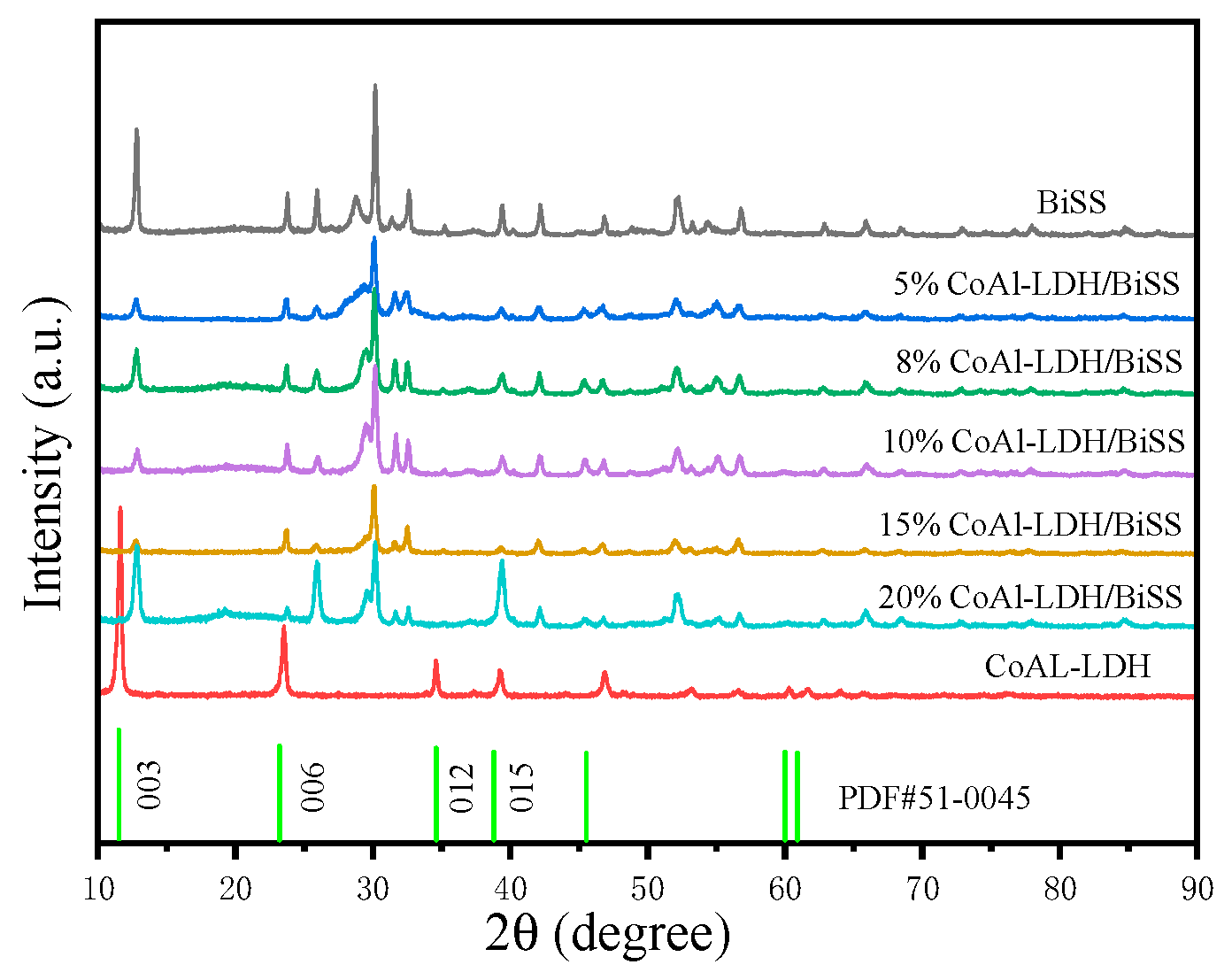

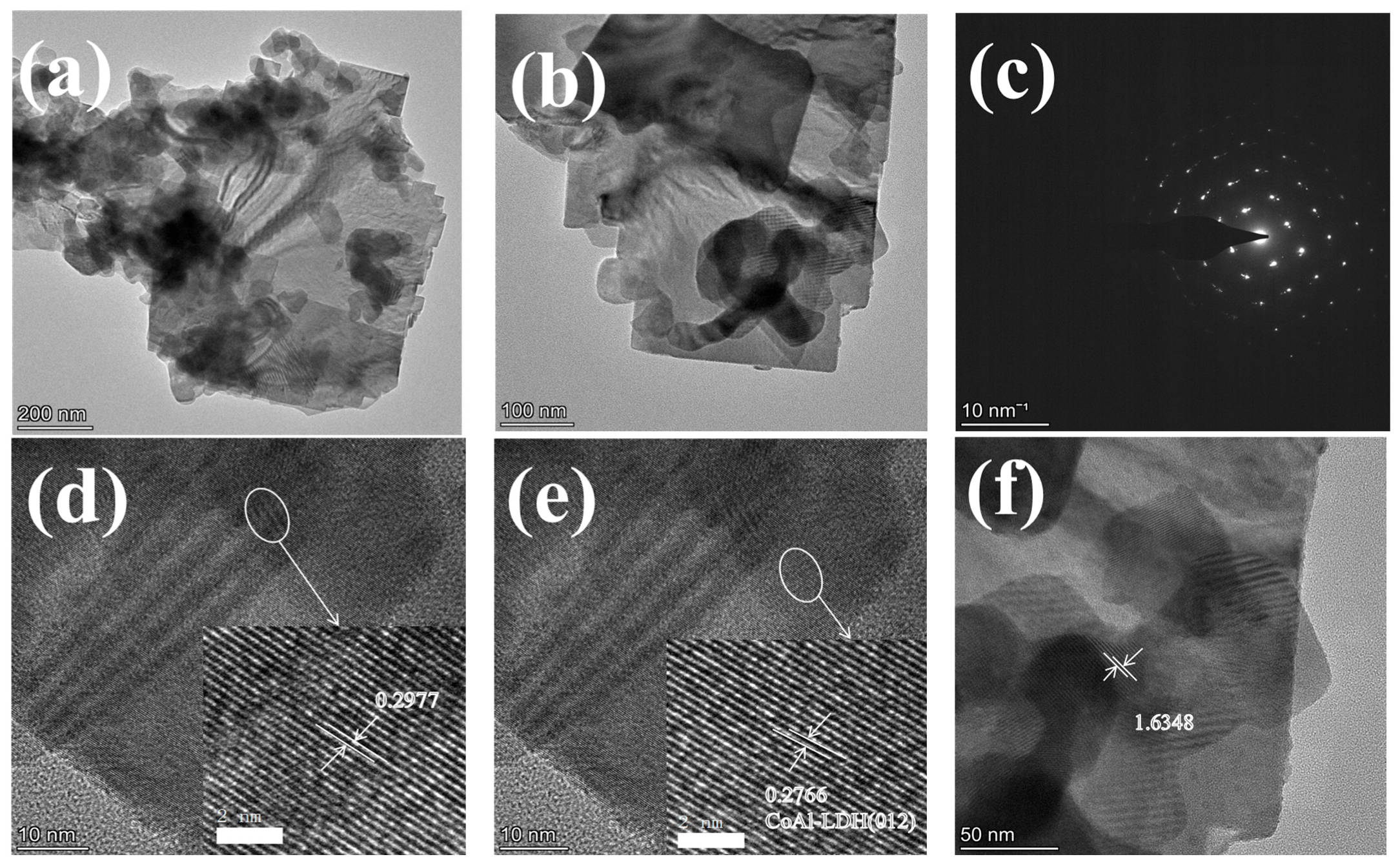
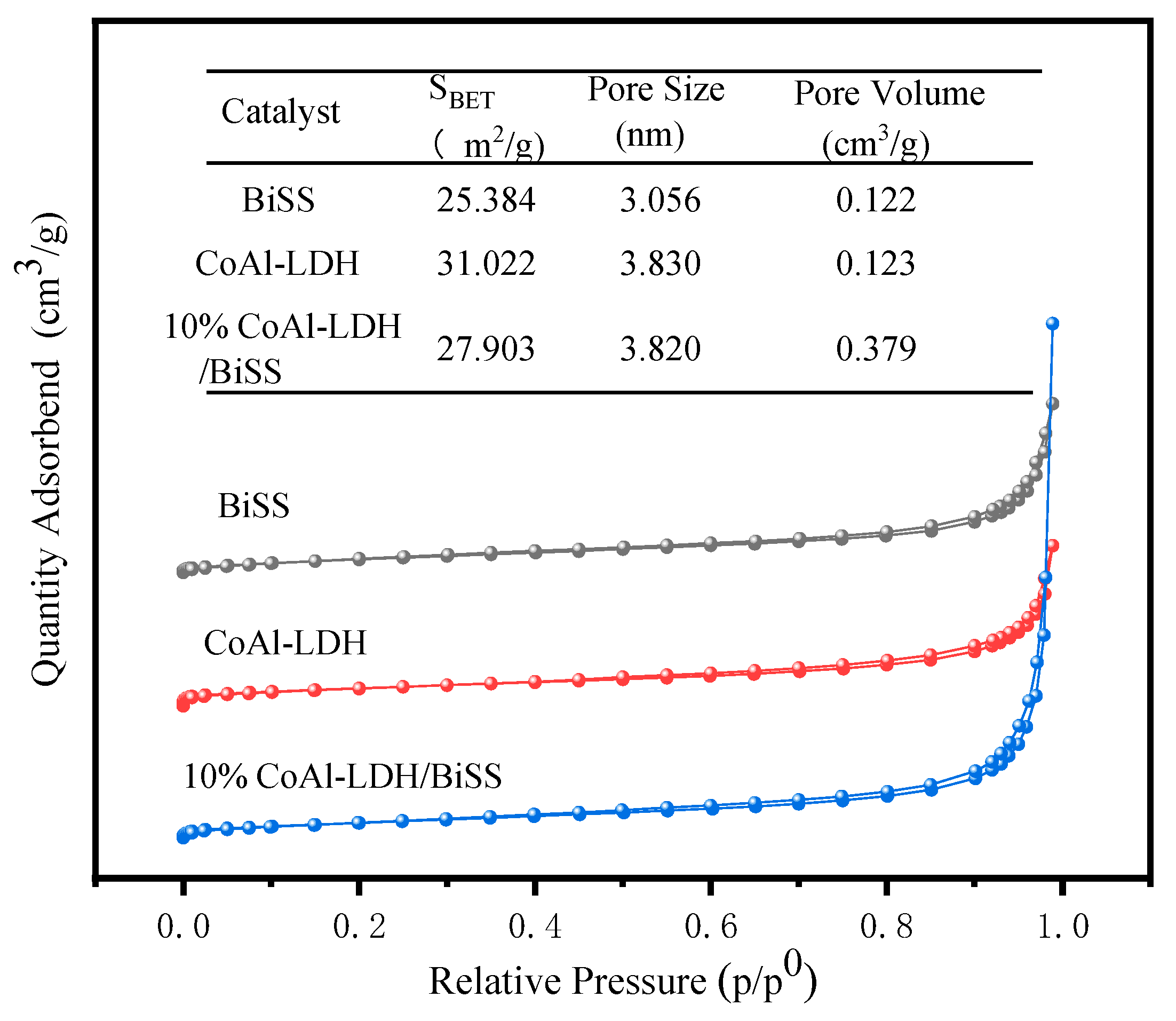


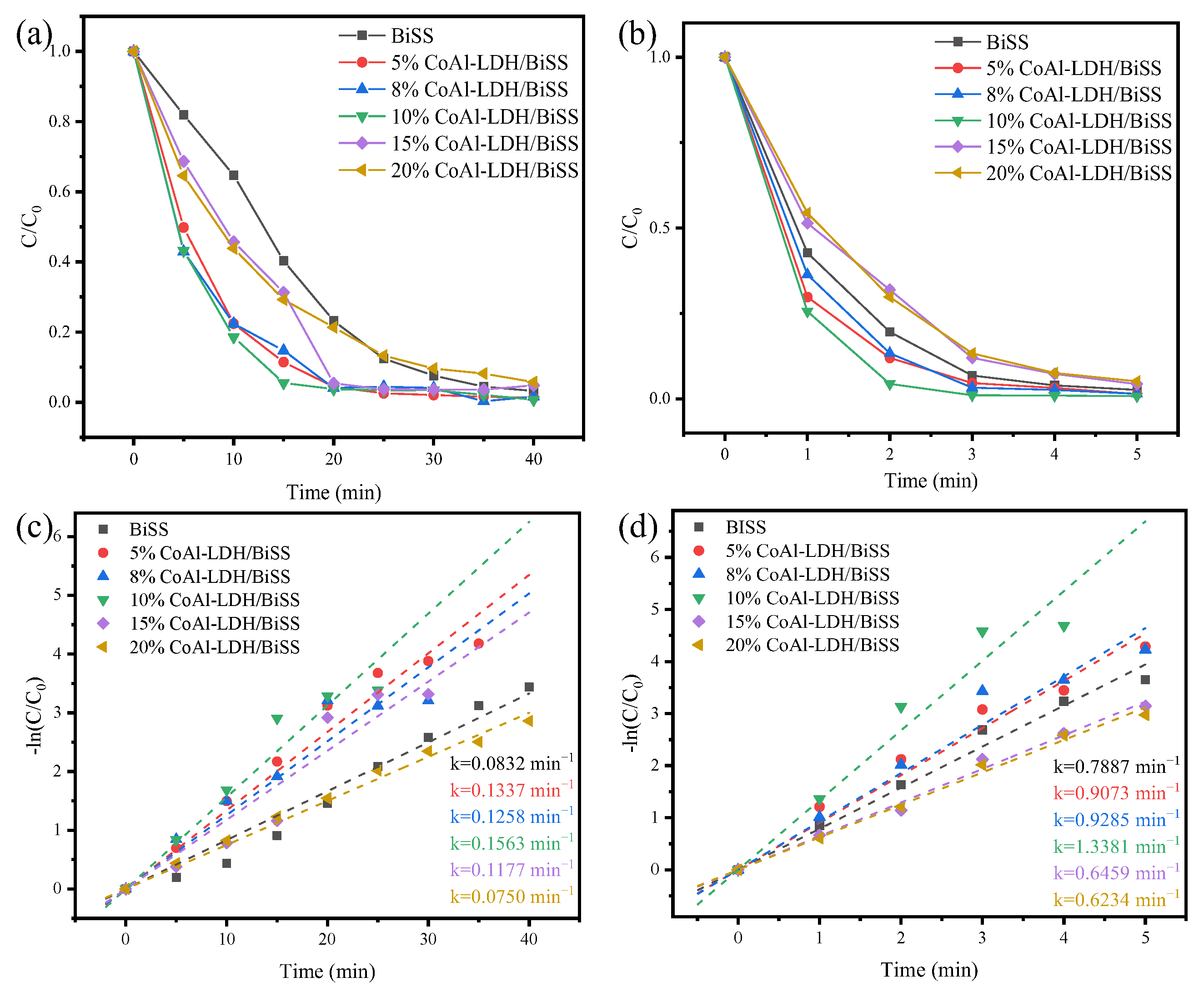
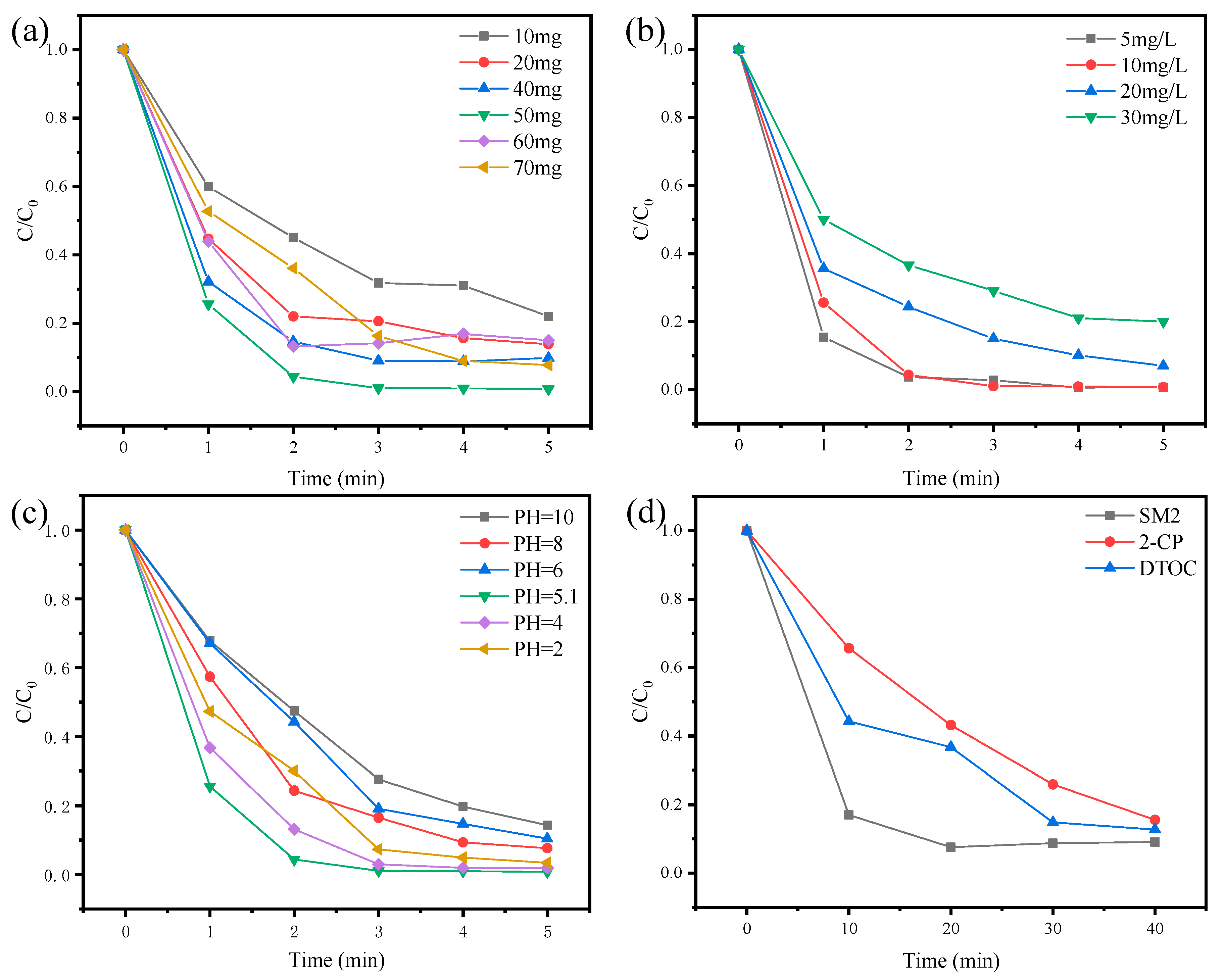
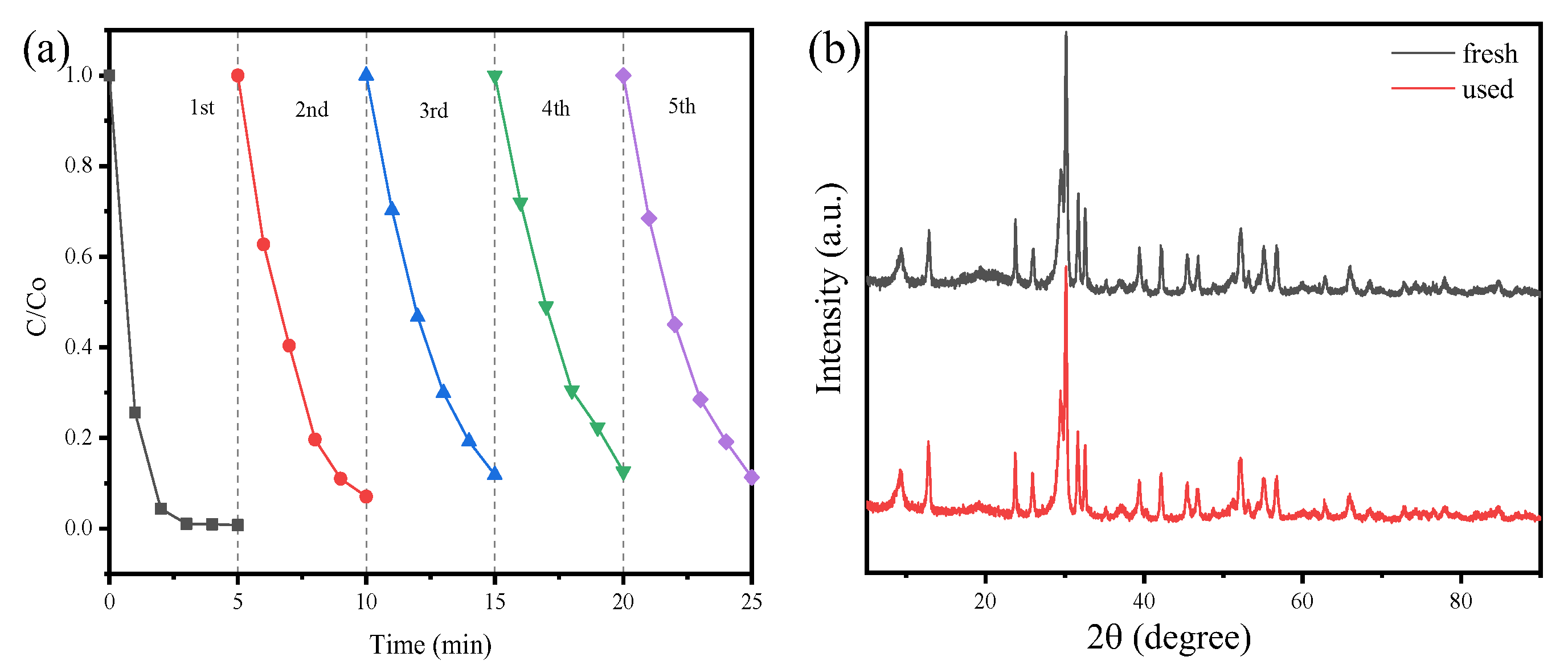
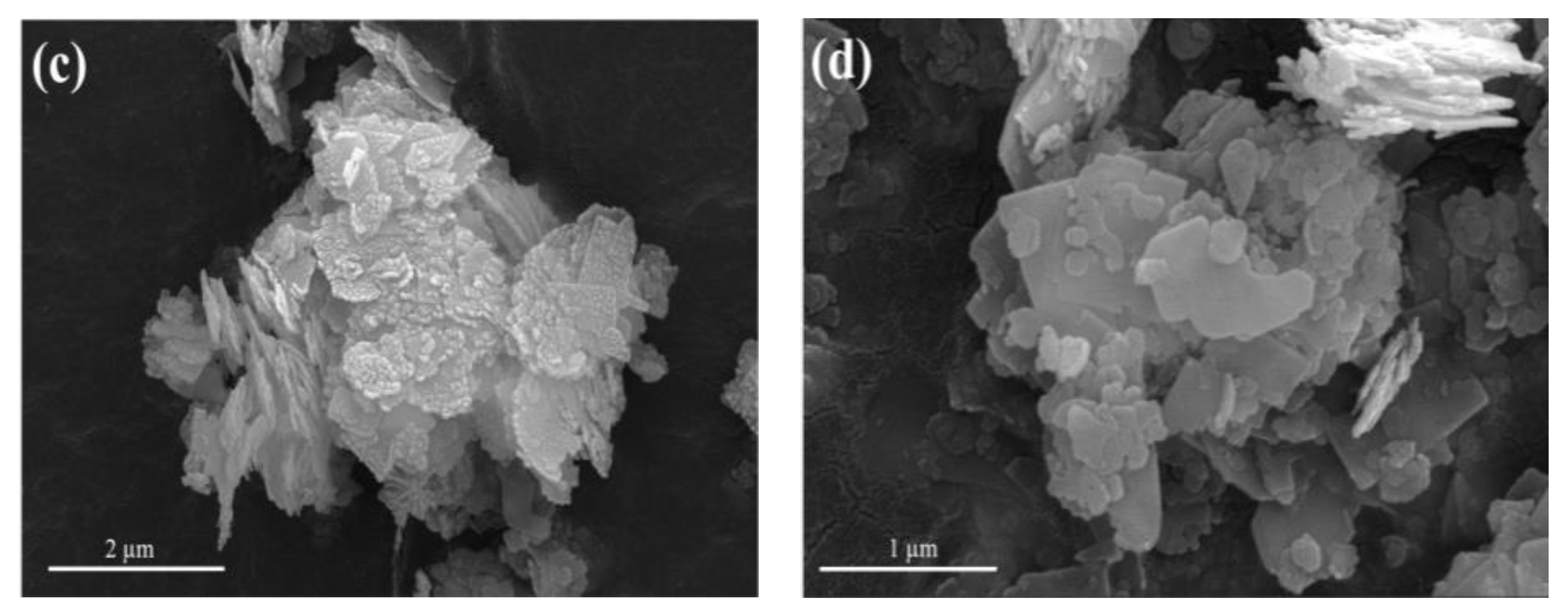

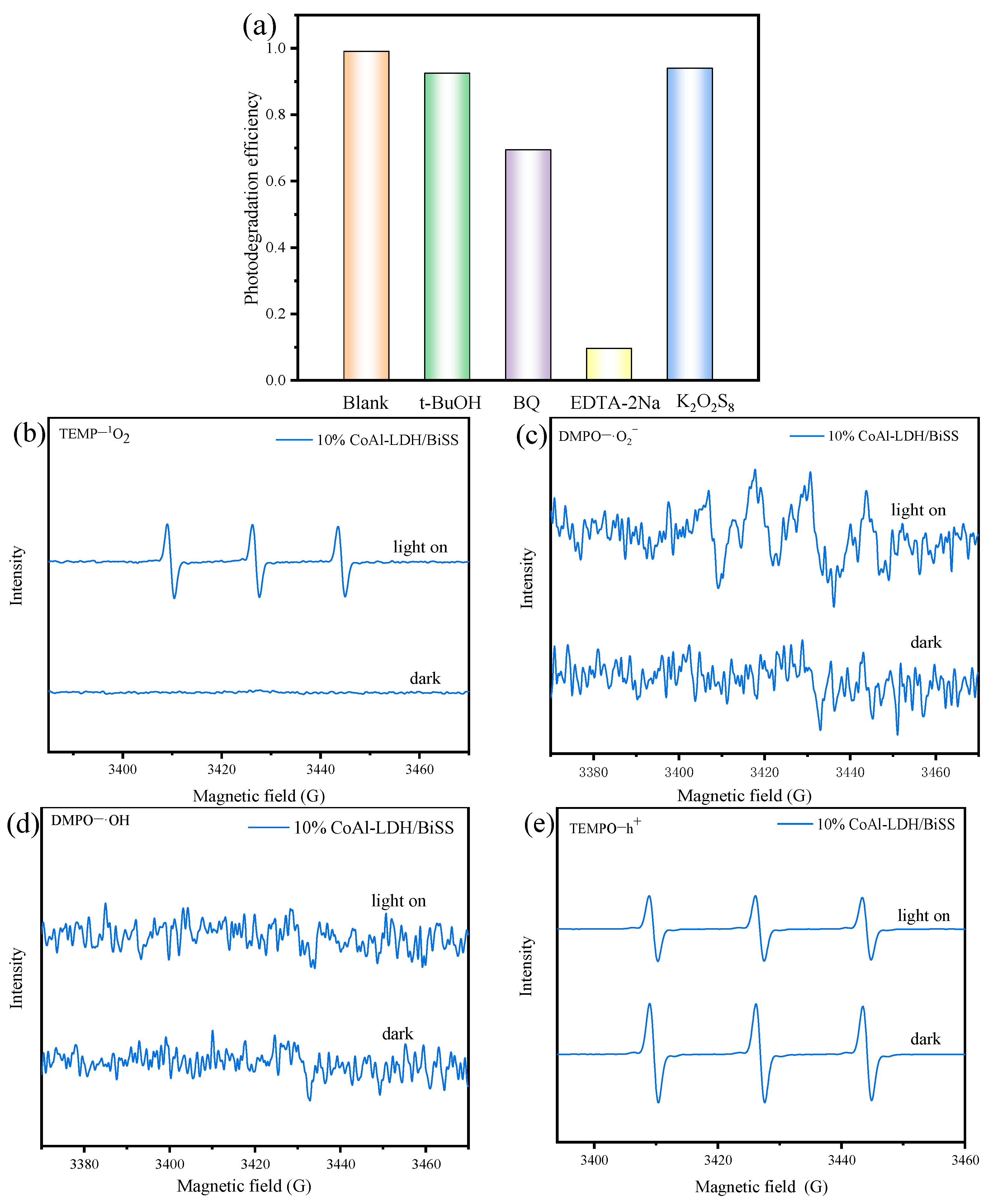



Disclaimer/Publisher’s Note: The statements, opinions and data contained in all publications are solely those of the individual author(s) and contributor(s) and not of MDPI and/or the editor(s). MDPI and/or the editor(s) disclaim responsibility for any injury to people or property resulting from any ideas, methods, instructions or products referred to in the content. |
© 2024 by the authors. Licensee MDPI, Basel, Switzerland. This article is an open access article distributed under the terms and conditions of the Creative Commons Attribution (CC BY) license (https://creativecommons.org/licenses/by/4.0/).
Share and Cite
Che, L.; Ji, H. Preparation of 2D/2D CoAl-LDH/BiO(OH)XI1−X Heterojunction Catalyst with Enhanced Visible–Light Photocatalytic Activity for Organic Pollutants Degradation in Water. Water 2024, 16, 1467. https://doi.org/10.3390/w16111467
Che L, Ji H. Preparation of 2D/2D CoAl-LDH/BiO(OH)XI1−X Heterojunction Catalyst with Enhanced Visible–Light Photocatalytic Activity for Organic Pollutants Degradation in Water. Water. 2024; 16(11):1467. https://doi.org/10.3390/w16111467
Chicago/Turabian StyleChe, Liying, and Huanhuan Ji. 2024. "Preparation of 2D/2D CoAl-LDH/BiO(OH)XI1−X Heterojunction Catalyst with Enhanced Visible–Light Photocatalytic Activity for Organic Pollutants Degradation in Water" Water 16, no. 11: 1467. https://doi.org/10.3390/w16111467



